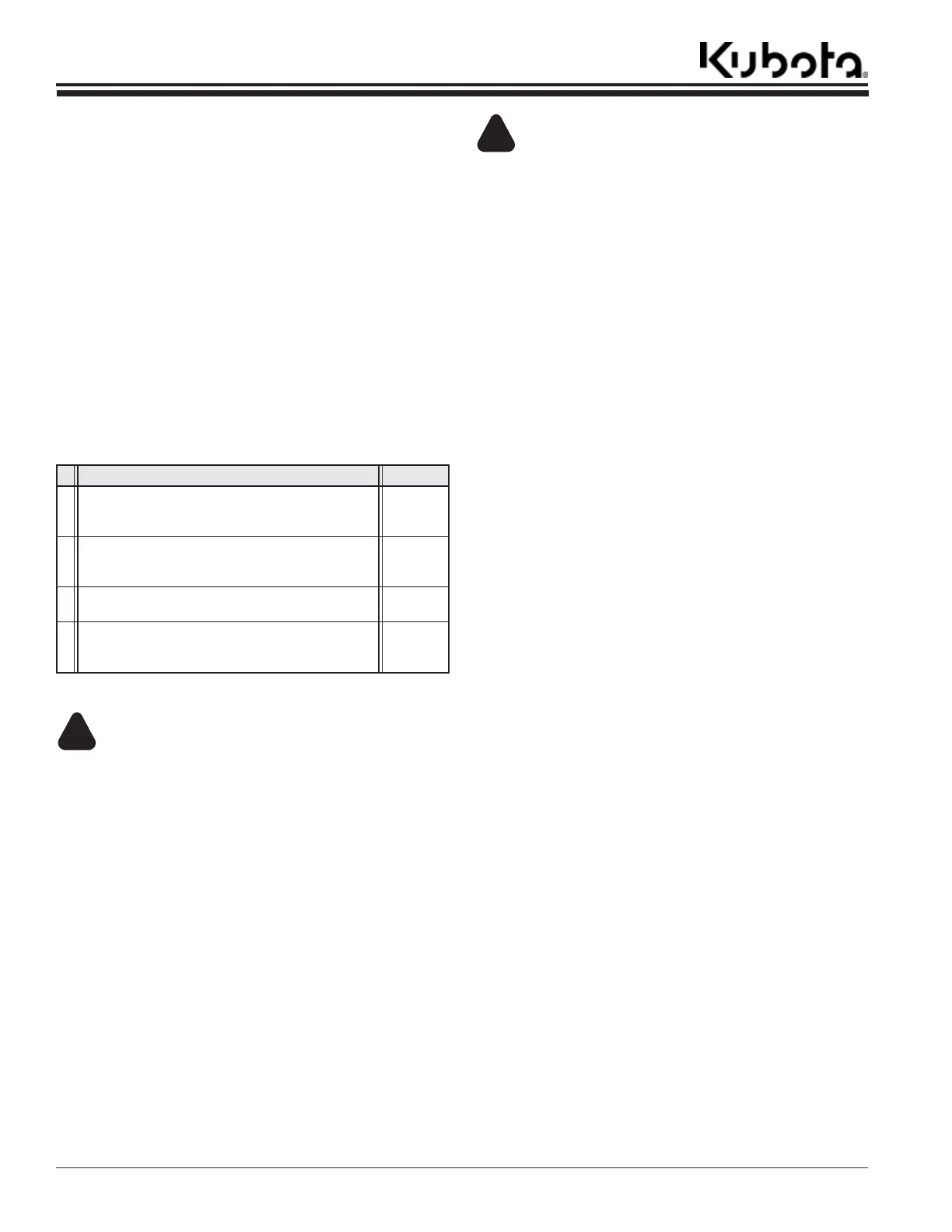Section 3: Operating Procedures
Table of Contents
AP-SC7072 Skid Cutter 326-974MK 2/6/19
14
Section 3: Operating Procedures
Operating Checklist
Hazard control and accident prevention are dependent
upon the awareness, concern, prudence, and proper
training involved in the operation, transport, storage and
maintenance of the Skid Cutter. Therefore, it is absolutely
essential that no one operates the Skid Cutter unless
they are age 16 or older and have read, fully understood,
and are totally familiar with the Operator’s Manual. Make
sure the operator has paid particular attention to:
• Important Safety Information, page 1
• Section 1: Assembly & Set-up, page 7
• Section 2: Adjustments, page 13
• Section 3: Operating Procedures, page 14
• Section 5: Maintenance & Lubrication, page 20
Perform the following inspections before using your
Skid Cutter.
Safety Information
DANGER
!
To avoid serious injury or death:
• Rotary Cutters have the ability to discharge objects at high
speeds; therefore, the use of front and rear safety guards is
mandatory when cutting along roadways and in areas where
people may be present. Stop blade rotation if a bystander is
in or around the area.
• Do not use cutter as a fan. Cutting blades are not properly
designed or guarded for this use.
• Do not operate cutter with skid shoes higher than 16 1/2"
off the ground. Always use height adjusting safety chain to
limit cutting height. Raising cutter too high will throw
debris at the operator.
• All guards and shields must be installed and in good
working condition while operating the attachment.
• Do not operate cutter after dark without working lights.
The equipment can hit unseen objects or be hit by other
vehicles. The operator can loose control of the power unit
and cutter causing a wreck or roll-over.
Operating Checklist
Check Ref.
Make sure guards and shields are in place and
secure. Make sure polycarbonate door is in
good working order.
Page 1
Inspect hydraulic hoses and replace if they are
worn, damaged, or leak.
Replace with genuine
OEM parts.
Page 3
Grease all fittings. Refer to “Lubrication
Points”.
Page 24
Check Skid Cutter initially and periodically for
loose bolts & nuts.
See “Torque Values Chart”.
Page 29
WARNING
!
To avoid serious injury or death:
• Hydraulic fluid under high pressure can penetrate the skin
and/or eyes causing a serious injury. Wear protective gloves
and safety glasses or goggles when working with hydraulic
systems. Use a piece of cardboard or wood rather than
hands when searching for leaks. A doctor familiar with this
type of injury must treat the injury within a few hours or
gangrene may result. DO NOT DELAY.
• Never carry riders on the attachment or power machine.
Riders can obstruct the operator’s view, interfere with
control of the equipment, be pinched by moving
components, become entangled in rotating components, be
struck by objects, be thrown or fall from the equipment, etc.
• Do not cut on steep inclines. The power machine could flip
over causing damage to the equipment and serious bodily
injury or death.
• Do not operate any hammer or mulching equipment on an
open cab machine or on a machine with a tempered front
glass window/door. We strongly recommend use of a
polycarbonate front glass door/window when operating any
hammer or mulching equipment.
• Allow only persons to operate this implement who have
fully read and comprehended this manual, who have been
properly trained in the safe operation of this implement, and
who are age 16 or older. Serious injury or death can result
from the inability to read, understand, and follow
instructions provided in this manual.
• Do not become entangled in hydraulic hoses while entering
or exiting the skid steer operator station.
• Do not operate cutter without a polycarbonate door
mounted to the cab and protective eye wear such as safety
glasses or goggles. Flying objects from the cutter can cause
serious injury to the body and eyes.
• Do not abuse equipment. Incorrect use of the attachment
can damage equipment structurally and cause serious
injury or death..
• Do not travel too fast. The rougher the terrain, the slower
you must travel. Always travel at a speed slow enough to be
able to adjust the deck height before running it into the
ground. Also, travel slow enough to stop before running or
turning into obstacles ahead and on either side.
• Do not use attachment to lift, carry, push or tow other
equipment and objects. It is not properly designed or
guarded for this use. The operator could lose control and
cause a tipping hazard.
• Do not use attachment to pull and/or pry fence posts,
stumps, roots, rocks, or other objects out of the ground. It is
not properly designed or guarded for this use.
• Do not use attachment as a lifting device for people or as a
work platform. It is not properly designed or guarded for
this use.
